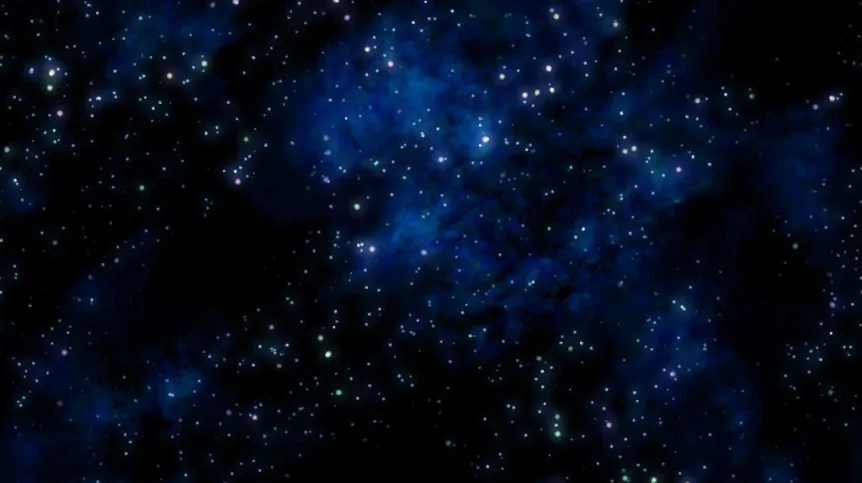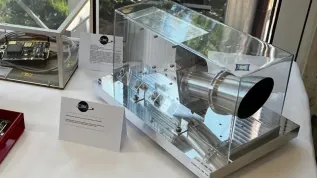
Around 1,500 asteroids approach Earth every year, says Lublin asteroid hunter Dr. Kacper Wierzchoś.
But, the 33-year-old astronomer who works at the Mt. Lemmon Sky Center Observatory near Tuscon, Arizona, told PAP that people should not worry as there won’t be an impact for at least 10 years.
PAP: What were the most important humanity's space research achievements in 2021?
K.W.: For me as a scientist involved in planetary defence, the most important achievement was the launch of NASA's first mission of planetary defence against near-Earth objects - DART. It is time to test new technologies and be prepared if, in the future, an asteroid is on a collision course with our planet. This is an unprecedented mission, the first attempt at planetary defence on a global scale by means of asteroid deflection. The DART impactor is now flying towards the asteroid Didimos and its small moon Dimorphos, which is the target of the impact. According to the calculations, the collision will take place in autumn 2022. Then NASA will examine changes in his orbit to verify if this is an effective method of defending our planet.
Another significant event in 2021 was SpaceX's testing of another Starship launch vehicle prototype expected to enable transport of people and goods to the Moon, and eventually take us to Mars. SpaceX now prepares its latest prototype for a historic orbit test flight.
PAP: Do any asteroids threaten us? In February 2020 you discovered the 'mini-moon', an asteroid pulled into Earth's orbit three years ago, but spotted in 2020. Sometimes we read that a dangerous asteroid flew past the Earth before scientists could spot it, because it approached from the direction of the Sun and was invisible as a result.
K.W.: There are asteroids that indeed constitute a huge challenge for us, because, approaching the Earth from the direction of the Sun, they are much more difficult to see. We are looking for asteroids by taking images of sections of the sky and editing them into short videos, 'gifs'. If something is moving in the video, it is an asteroid or a comet, because stars do not move. Of course, such work is only possible at night.
The famous Chelyabinsk meteor, the largest known natural object to have entered Earth's atmosphere since the 1908 Tunguska event, came unnoticed from the direction of the Sun and in 2013 exploded over Chelyabinsk Oblast in Russia. Although it exploded at a height of more than 29 km above the Earth surface, a strong shock wave caused significant damage - 1,500 people were injured and over 7,500 buildings damaged. The energy of the explosion was equivalent to the explosion of 30 atomic bombs, like the one detonated at Hiroshima. It is because of such asteroids we never sleep at the Mt. Lemmon Sky Center Observatory. During the year, we discover almost 1,500 asteroids that are approaching Earth.
PAP: Can the rest of humanity sleep peacefully?
K.W.: Yes, according to NASA, any known asteroid's collision with Earth over the next 100 years is impossible. I want to emphasize that Catalina Sky Survey (CSS), for which I work, is currently the largest near-Earth objects (NEOs) search program. This planetary defence project is financed by NASA. Currently, we use four telescopes to detect NEOs and study their orbits. We know 26,782 NEOs, and CSS detected 47 percent of them.
To give you some peace of mind, I will also add that the work on new methods of detection of NEOs continues. In 2026, NASA plans to launch a space telescope that will show 90 percent of objects with a diameter above 140 m. And if the DART mission proves to be a success, we will have a way to protect all humanity against an asteroid threat.
PAP: In addition to hundreds of asteroids, you discovered three comets that bear your name. Comets were also the subject of your doctoral work at the University of South Florida. What is so special about comets?
K.W.: Our mission in CSS is to search for and observe NEOs, but we sometimes catch objects that do not look like asteroids. Comets usually have a coma and a tail, and asteroids look like moving stars. Comets, made of a mixture of ice, rock and dust, are fascinating. No two comets are alike, each one is different and noteworthy. As they approach the Sun, ice sublimates from their surface. The resulting gases carry dust and form a shell called a coma. Then, the tail of the comet also forms.
On the other hand, asteroids are rocks with a diameter from 1 m to tens of km that do not exhibit the activity of comets. To date, around 1 million asteroids and 6,000 comets have been discovered, including those discovered before the invention of the telescope. There are many more asteroids than comets. Small asteroids or their fragments often enter the Earth's atmosphere, which we see as shooting stars.
PAP: Did the water come to Earth with comets? Did life? Do comets carry organic matter, traces of life?
K.W.: There are many hypotheses about the origin of water on Earth. So far, it is not known for sure where most of the water on our planet came from. Certainly some of it comes from comets from the early days of the Solar System, but we don't know how much. When it comes to life on Earth, there is the panspermia hypothesis, with varying degrees of acceptance in the scientific community, that life came with comets, space dust and asteroids. Comets contain a lot of organic compounds, for example, 67P/Churyumov–Gerasimenko, on the surface of which the European space probe Rosetta's lander landed in 2014, was found to contain glycine - an amino acid. Another comet, C/2014 Q2 (Lovejoy), contains simple sugar and ethyl alcohol, just like the one we drink. This comet released an amount of alcohol equal to 500 bottles of wine per second, and the media dubbed it the 'drunk comet'. Scientists found over 20 different organic particles in its tail.
These, however, are not traces of life. In addition to organic chemicals, life requires energy to develop. Organic compounds, as the basic building blocks of life, may be associated with occurrence in organisms, but this does not mean that they were ever part of one. Organic substances can be produced by both biological and non-biological methods.
PAP: Comets have been observed in the sky from the earliest times. But instead of awe, they caused anxiety and fear of misfortune. I could joke that when you discovered your first comet, the coronavirus pandemic was just beginning, and when you discovered the second one, a volcano erupted on the Spanish island of La Palma.
K.W.: I didn't notice these connections (laughs). But seriously: the unknown has always scared people. Humanity watched the sky and saw repetitive, predictable cycles, the movement of the planets, the Sun and the Moon. The unexpected appearance of bright comets in the sky, visible for weeks or months, was disturbing. I must admit that when I saw the very bright C/2020 F3 (NEOWISE) comet visible to the naked eye in July 2020, I experienced a kind of primitive feeling that 'it should not be there'.
PAP: Can we talk about Polish achievements in discovering new comets?
K.W.: Of course, Poland has many achievements in this area, although we must distinguish between technical discoveries and scientifically recognized ones. There are amateur comet hunters who search for these objects by analysing images from the SOHO space probe. These are publicly available images and anyone can access them online. Such discoveries are called SOHO, not with the name of the discoverer. There are a lot of SOHO comet discoverers in Poland, which is great. In November 2020, a 12-year-old boy, Rafał Biros, discovered one of the SOHO comets. He is the youngest comet discoverer in the world, he has a future!
In order for a comet to be named after its discoverer, the discoverer must use a telescope, take pictures, describe it, record its activity and send this information to an organization that collects observation data of the small Solar System objects (asteroids and comets) - the Minor Planet Center.
So far, scientifically recognized Polish comet discoverers are: Antoni Wilk (4 comets), Kacper Wierzchoś (3 comets), Lucjan Orkisz (1), Władysław Lis (1), Konrad Rudnicki (1), Grzegorz Pojmański (1). A special case is the comet C/2015 F2 (Polonia) discovered by Michał Kusiak, Michał Żołnowski, Rafał Reszelewski and Marcin Gędek. They belong to the second group of discoverers, but since the name of a comet can include up to three people's names, and there were four of them, they called it 'Polonia', which I find very beautiful.
I would like to add that one of my idols is the Polish astronomer Antoni Wilk, who lived at the turn of the 20th century. I consider him to be the greatest Polish 'comet hunter' in history. Not only did he discover four comets, he 'hunted' them from the balcony of his apartment using military binoculars, it's amazing!
PAP: On the one hand, we have the rapid development of science and many important discoveries, even in physics, and on the other hand, we observe a strange apology of ignorance. Canadian researcher based in Barcelona, Catherine L'Ecuyer, recently stated that ignorance is becoming a social value, even posing as moral superiority. According to her, anti-intellectualism is fashionable. In Spain, we see these trends even in education, justified by ideological reasons. Isn't that a paradox?
K.W.: As a scientist, I am very concerned about this. Scientific discoveries are made with scientific methodology, the proper collection of information used to discover the truth. Meanwhile, I am now watching scientists who spend half their lives in the lab developing vaccines against viruses, ridiculed by anti-vaccines who think they know better. It's as if I suddenly discovered a dangerous asteroid that is about to hit the Earth, and some Joe says that it's nonsense, because he saw on YouTube that the mechanics of the sky (the theory of the movement of celestial bodies) is false. I hope it doesn't come to that.
PAP: What are your thoughts when you watch the sky at night?
K.W.: Exploring the cosmos makes us realize how insignificant we are in the scale of the Universe. It is beautiful to be able to directly, through a telescope, witness the existence of galaxies, nebulae, globular clusters because these cosmic bodies are my future and the future of all of us. Someday, our planet will cease to exist and everything will become stardust. Human consciousness is a window, through which the Universe looks at itself. When I watch the sky through a telescope, I experience something mystical.
PAP: Are you in contact with Polish astronomers (or they with you)?
K.W: Yes, I stay in touch with a few of them via the Internet, mainly Michał Kusiak and Michał Żołnowski, co-discoverers of the comet C/2021 F2 (Polonia). I am proud to say that last month they named one of the main belt asteroids (between the orbits of Mars and Jupiter) after me. They named it (594782) Kacperwierzchos. It is an honour!
Kacper Wierzchoś was born in Lublin. He works at the Mt. Lemmon Sky Center Observatory near Tuscon, Arizona, in the Catalina Sky Survey research program, the purpose of which is to search for asteroid, comets and other potentially dangerous objects close to Earth. This is part of the NASA planetary defence program. In February 2020, he and Theodore Pruyne discovered a 'mini-moon' orbiting the Earth - an asteroid pulled into Earth's orbit. In April 2020, the Polish astronomer discovered another object, this time a long-period comet C/2020 H3 (Wierzchoś), and in September 2021 another comet - P/2021 R4 (Wierzchoś). In October 2021, he discovered his third comet P/2021 U1 (Wierzchoś).
Grażyna Opińska (PAP)
opi/ adj/ kap/
tr. RL













